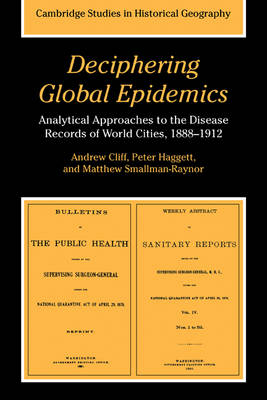
Deciphering Global Epidemics
Analytical Approaches to the Disease Records of World Cities, 1888–1912
Seiten
1998
Cambridge University Press (Verlag)
978-0-521-47860-1 (ISBN)
Cambridge University Press (Verlag)
978-0-521-47860-1 (ISBN)
The authors uses data collected for 350 cities around the world to paint a picture of global mortality trends at the turn of the twentieth century. The authors analyse data on diphtheria, enteric fever, measles, scarlet fever, tuberculosis, and whooping cough, and death from all causes, to give insights into patterns of mortality from these diseases.
Using data collected for 350 cities from around the world, the authors use a variety of analytical methods to provide a global picture of what was happening to infectious epidemic diseases at a critical period in urban evolution on the international stage. The diseases considered are diphtheria, enteric fever, measles, scarlet fever, tuberculosis, and whooping cough. To place the results in a wider time context, other data are used to look both backwards and forwards for nearly a century on either side of the twenty-five-year time window. The book presents a number of results that may be interpreted in the context of debates on the causes of long-term mortality decline from these infectious diseases. It will be of interest to students of demography, history of medicine, and economic history as well as to researchers already active in these fields.
Using data collected for 350 cities from around the world, the authors use a variety of analytical methods to provide a global picture of what was happening to infectious epidemic diseases at a critical period in urban evolution on the international stage. The diseases considered are diphtheria, enteric fever, measles, scarlet fever, tuberculosis, and whooping cough. To place the results in a wider time context, other data are used to look both backwards and forwards for nearly a century on either side of the twenty-five-year time window. The book presents a number of results that may be interpreted in the context of debates on the causes of long-term mortality decline from these infectious diseases. It will be of interest to students of demography, history of medicine, and economic history as well as to researchers already active in these fields.
List of figures; List of plates; List of tables; Foreword; Preface; 1. Prologue: epidemics past; 2. The nature of the evidence; 3. The global sample: an overall picture; 4. Epidemic trends: a global synthesis; 5. Comparing world regions; 6. The individual city record; 7. Epidemics: looking forwards; Appendices; References.
| Erscheint lt. Verlag | 28.8.1998 |
|---|---|
| Reihe/Serie | Cambridge Studies in Historical Geography |
| Zusatzinfo | 43 Tables, unspecified; 11 Halftones, unspecified |
| Verlagsort | Cambridge |
| Sprache | englisch |
| Maße | 154 x 230 mm |
| Gewicht | 795 g |
| Themenwelt | Studium ► Querschnittsbereiche ► Epidemiologie / Med. Biometrie |
| Studium ► Querschnittsbereiche ► Geschichte / Ethik der Medizin | |
| ISBN-10 | 0-521-47860-X / 052147860X |
| ISBN-13 | 978-0-521-47860-1 / 9780521478601 |
| Zustand | Neuware |
| Haben Sie eine Frage zum Produkt? |
Mehr entdecken
aus dem Bereich
aus dem Bereich
ein überfälliges Gespräch zu einer Pandemie, die nicht die letzte …
Buch | Hardcover (2024)
Ullstein Buchverlage
24,99 €


